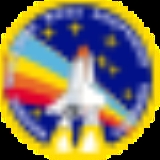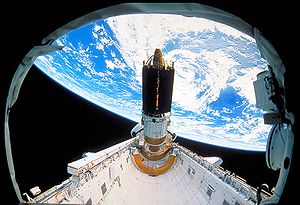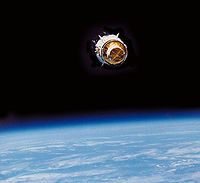
STS-29
Encyclopedia
Mission parameters
- MassMassMass can be defined as a quantitive measure of the resistance an object has to change in its velocity.In physics, mass commonly refers to any of the following three properties of matter, which have been shown experimentally to be equivalent:...
:- Orbiter liftoff: 116281 kilograms (256,355.7 lb)
- Orbiter landing: 88353 kilograms (194,785 lb)
- Payload: 17280 kilograms (38,095.9 lb)
- PerigeePerigeePerigee is the point at which an object makes its closest approach to the Earth.. Often the term is used in a broader sense to define the point in an orbit where the orbiting body is closest to the body it orbits. The opposite is the apogee, the farthest or highest point.The Greek prefix "peri"...
: 297 kilometres (184.5 mi) - Apogee: 308 kilometres (191.4 mi)
- InclinationInclinationInclination in general is the angle between a reference plane and another plane or axis of direction.-Orbits:The inclination is one of the six orbital parameters describing the shape and orientation of a celestial orbit...
: 28.5° - PeriodOrbital periodThe orbital period is the time taken for a given object to make one complete orbit about another object.When mentioned without further qualification in astronomy this refers to the sidereal period of an astronomical object, which is calculated with respect to the stars.There are several kinds of...
: 90.6 min
Mission summary
Space Shuttle Discovery lifted off from Pad B, LaunchComplex 39, Kennedy Space Center, at 9:57 am EST on 13 March 1989. The launch was
originally scheduled for 18 February, but was postponed to allow for the
replacement of faulty liquid oxygen
Liquid oxygen
Liquid oxygen — abbreviated LOx, LOX or Lox in the aerospace, submarine and gas industries — is one of the physical forms of elemental oxygen.-Physical properties:...
turbopumps on the three main
engines. The amended target date of 11 March also proved unviable because of
the failure of a master event controller when it was powered up
during prelaunch checkout; the controller was quickly replaced. On the
rescheduled launch day of 13 March, the launch was delayed for nearly two hours because of ground fog and high upper winds. A waiver was approved for the orbiter's wing loads.

Tracking and Data Relay Satellite
Tracking and Data Relay Satellite
A Tracking and Data Relay Satellite is a type of communications satellite that forms part of the Tracking and Data Relay Satellite System used by NASA and other United States government agencies for communications to and from independent "User Platforms" such as satellites, balloons, aircraft,...
(TDRS) constellation in
geosynchronous orbit. The three on-orbit satellites were stationed
over the equator at about 22,300 miles above Earth; two of them were positioned 130
degrees apart, while the third was located between them as an on-orbit spare.
On Flight Day 1, one of three cryogenic hydrogen tanks which
supplied shuttle's electricity-generating fuel cells exhibited erratic
pressure fluctuations. It was deactivated while engineers studied the
problem, and the crew was told to conserve electrical power. The tank
was reactivated on Flight Day 3, 15 March, and operated successfully thereafter.
Discovery landed on 18 March 1989, after orbit 80, one orbit earlier
than planned, in order to avoid possible excessive wind buildup
expected at the landing site. The shuttle touched down on Runway 22 at Edwards
Air Force Base, California
California
California is a state located on the West Coast of the United States. It is by far the most populous U.S. state, and the third-largest by land area...
, at 9:35 am EST. The total mission duration was 4 days, 23
hours, and 39 minutes.
Payload and experiments
The mission's primary payload was a Tracking and Data Relay Satellite (TDRS-D), which became TDRS-4 after deployment, and its attached Inertial Upper Stage (IUS). The satellite was deployed from the shuttle's payload bay less than sixhours after launch, at 3:12 am EST. The first-stage orbit burn of the
IUS took place an hour later, and the second burn to circularize the
orbit occurred 12 hours and 30 minutes into the mission. The satellite was
stationed at 41 degrees west longitude
Longitude
Longitude is a geographic coordinate that specifies the east-west position of a point on the Earth's surface. It is an angular measurement, usually expressed in degrees, minutes and seconds, and denoted by the Greek letter lambda ....
.

Student Involvement Program experiments. One student experiment,
using four live rats
RATS
RATS may refer to:* RATS , Regression Analysis of Time Series, a statistical package* Rough Auditing Tool for Security, a computer program...
with tiny pieces of bone removed from their bodies, was to test
whether the environmental effects of space flight inhibit bone
healing. The other student experiment was to fly 32 chicken
Chicken
The chicken is a domesticated fowl, a subspecies of the Red Junglefowl. As one of the most common and widespread domestic animals, and with a population of more than 24 billion in 2003, there are more chickens in the world than any other species of bird...
eggs
Egg (food)
Eggs are laid by females of many different species, including birds, reptiles, amphibians, and fish, and have probably been eaten by mankind for millennia. Bird and reptile eggs consist of a protective eggshell, albumen , and vitellus , contained within various thin membranes...
to
determine the effects of space flight on fertilized chicken embryo
Embryo
An embryo is a multicellular diploid eukaryote in its earliest stage of development, from the time of first cell division until birth, hatching, or germination...
s.
One experiment, mounted in the payload bay, was only termed
"partially successful." The Space Station Heat Pipe Advanced Radiator
Element, a potential cooling system for the planned Space Station Freedom
Space Station Freedom
Space Station Freedom was a NASA project to construct a permanently manned Earth-orbiting space station in the 1980s. Although approved by then-president Ronald Reagan and announced in the 1984 State of the Union Address, Freedom was never constructed or completed as originally designed, and after...
,
operated continuously for less than 30 minutes under powered
electrical loads. The failure was blamed on the faulty design of the
equipment, especially the manifold section.
All other experiments operated successfully. Crystals were obtained from all the protein
Protein
Proteins are biochemical compounds consisting of one or more polypeptides typically folded into a globular or fibrous form, facilitating a biological function. A polypeptide is a single linear polymer chain of amino acids bonded together by peptide bonds between the carboxyl and amino groups of...
s in the Protein Crystal Growth experiment. The Chromosomes and Plant Cell Division in Space (CHROMEX), a life sciences experiment, was designed to show the effects of microgravity on root development. An IMAX
IMAX
IMAX is a motion picture film format and a set of proprietary cinema projection standards created by the Canadian company IMAX Corporation. IMAX has the capacity to record and display images of far greater size and resolution than conventional film systems...
(70 mm) camera was used to film a variety of scenes, including the effects of floods, hurricanes, fires and volcanic eruptions on Earth. A ground-based US Air Force experiment used the orbiter as a calibration target for the Air Force Maui Optical Site (AMOS) in Hawaii
Hawaii
Hawaii is the newest of the 50 U.S. states , and is the only U.S. state made up entirely of islands. It is the northernmost island group in Polynesia, occupying most of an archipelago in the central Pacific Ocean, southwest of the continental United States, southeast of Japan, and northeast of...
.
Wake-up calls
NASA began a tradition of playing music to astronauts during the Gemini program, and first used music to wake up a flight crew during Apollo 15Apollo 15
Apollo 15 was the ninth manned mission in the American Apollo space program, the fourth to land on the Moon and the eighth successful manned mission. It was the first of what were termed "J missions", long duration stays on the Moon with a greater focus on science than had been possible on previous...
. Each track is specially chosen, often by the astronauts' families, and usually has a special meaning to an individual member of the crew, or is applicable to their daily activities.
| Flight Day | Song | Artist/Composer |
|---|---|---|
| Day 2 | "I Got You (I Feel Good) I Got You (I Feel Good) "I Got You " is a hit song by James Brown. Released as a single in 1965, it was one of Brown's signature songs, and is arguably his most widely-known recording.-Description:... " |
James Brown James Brown James Joseph Brown was an American singer, songwriter, musician, and recording artist. He is the originator of Funk and is recognized as a major figure in the 20th century popular music for both his vocals and dancing. He has been referred to as "The Godfather of Soul," "Mr... |
| Day 3 | "Marine Corps Hymn" | |
| Day 4 | "Theme from Star Trek: TOS" | Jerry Goldsmith Jerry Goldsmith Jerrald King Goldsmith was an American composer and conductor most known for his work in film and television scoring.... |
| Day 5 | "Heigh-Ho Heigh-Ho "Heigh-Ho" is a song from Walt Disney's 1937 animated film Snow White and the Seven Dwarfs, written by Frank Churchill and Larry Morey... " |
Song from the Walt Disney Walt Disney Walter Elias "Walt" Disney was an American film producer, director, screenwriter, voice actor, animator, entrepreneur, entertainer, international icon, and philanthropist, well-known for his influence in the field of entertainment during the 20th century. Along with his brother Roy O... animated film Snow White Snow White "Snow White" is a fairy tale known from many countries in Europe, the best known version being the German one collected by the Brothers Grimm... |
| Day 6 | "What a Wonderful World What a Wonderful World "What a Wonderful World" is a song written by Bob Thiele and George David Weiss. It was first recorded by Louis Armstrong and released as a single in 1968. Thiele and Weiss were both prominent in the music world . Armstrong's recording was inducted in the Grammy Hall of Fame in 1999... " |
Louis Armstrong Louis Armstrong Louis Armstrong , nicknamed Satchmo or Pops, was an American jazz trumpeter and singer from New Orleans, Louisiana.... |
See also
- SpaceflightSpaceflightSpaceflight is the act of travelling into or through outer space. Spaceflight can occur with spacecraft which may, or may not, have humans on board. Examples of human spaceflight include the Russian Soyuz program, the U.S. Space shuttle program, as well as the ongoing International Space Station...
- Space Shuttle programSpace Shuttle programNASA's Space Shuttle program, officially called Space Transportation System , was the United States government's manned launch vehicle program from 1981 to 2011...
- List of space shuttle missions
- List of human spaceflights chronologically

